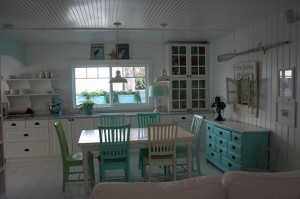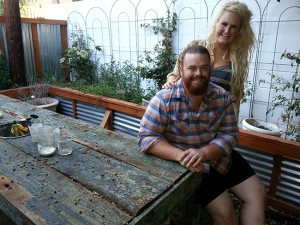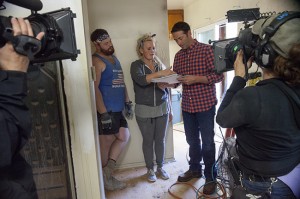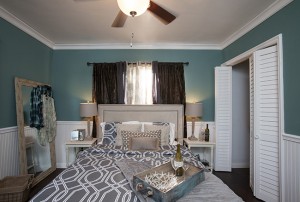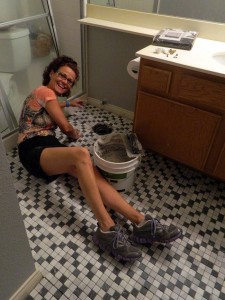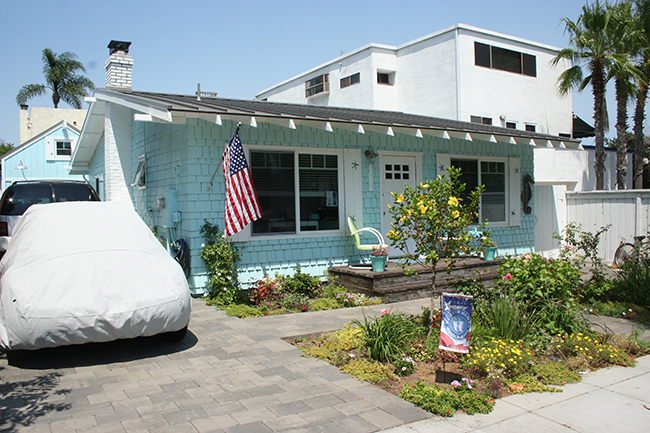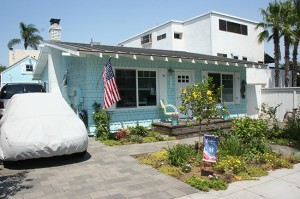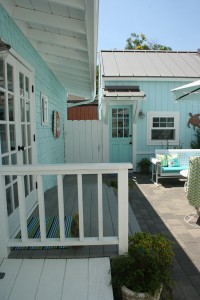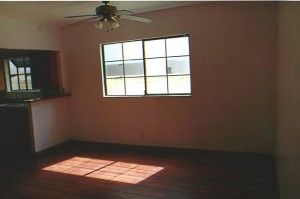After living amid a sea of brown and beige homes in Peoria, Ariz., the Schmid family jumped at the opportunity to buy a little yellow house on Fourth Avenue in Coronado. But the cottage was in need of some TLC — and some major elbow grease. “It was the only house on the island we could afford — we saw it as our one opening and we jumped on it,” said Kim Schmid, who owns the home with her husband, Michael. Even though it needed a lot of work, “I saw the potential in it — I could see it for what it would be rather than what it was at the time.”
The Schmids and their four children got to work gutting, painting, even installing insulation and cabinetry. “This was truly a family effort by all six of us — everyone tirelessly worked to make the dream come true for our family, and we had so much fun doing it,” said Schmid. Now the family lives in a house full of memories from the experience — like the time when they posed for a picture with machetes after successfully hacking out the front yard together.
Schmid paid painstaking attention to every detail to make the home their own. Personal touches such as bead boarding (a decorative style of wood paneling) and bold decisions with paint colors brought Schmid’s dream to life: “It’s everything I ever wanted in a beach cottage. Being able to paint the kitchen floors white and the exterior of the house aqua was so freeing for me!”
Before purchasing the island cottage, the family bought and renovated a condominium in Peoria and rented out the property. Between that and their successful renovation of their Coronado home, the Schmids are now embarking on some home-flipping projects in San Diego.
“Flipping” homes — buying distressed homes for bargain prices, and then renovating and reselling them within a very short time frame — is often a very profitable endeavor. In addition to the income potential of flipping homes, Schmid explained, “It’s always been a passion of mine to take the ugly duckling and make it beautiful. I believe you can really make money at it when you infuse personality and character into a home — whether by enhancing what was already there or by adding it if it was missing.”
Flipping homes has become a national obsession. DIY (Do-It-Yourself) websites, magazines and seminars abound, offering advice and instruction for the novice flipper. But perhaps the most telling indicator of this trend’s popularity is the dozen or so cable TV shows dedicated to the practice.
Coronado resident Amanda Marks and her boyfriend, Curtis Goldin, recently experienced the flipping madness first-hand. “In September, my sister Aubrey was looking through jobs on Craigslist and came across this notice from HGTV (Home and Garden Television Network) saying they were looking for couples with an ‘eye for design,’” Marks recalled.
Goldin and Marks had just finished cleaning and redesigning Marks’ backyard patio, which included building a huge dining table from salvaged ship-wood. (Marks laughed, saying, “I like to find ‘trash’ and turn it into something cool.”) That project, along with Marks’ penchant for designing interiors in “beachy, Bohemian chic” and Goldin’s background in construction, motivated the couple to audition for the show.
“We didn’t even know what the show was about. We went down in jeans, boots and plaid shirts, and the people there were in suits. We thought, ‘well we blew this,’” said Marks. But the couple’s easy charm and skills —HGTV describes them as “free-spirited personalities with a knack for offbeat but beautiful construction” — snagged them the job.
The premise of the show, called “Flipping the Block,” is four couples rehabbing and renovating four identical, dilapidated condos in Glendale for a chance to win a $50,000 cash prize. Filming of the eight-week series began in February and premiered on HGTV July 20. The winner will be determined when the condos are ultimately “flipped” at auction. (The finale airs Sunday, Sept. 7 at 9 p.m.)
Over a period of two months, Marks and Goldin, dubbed “The Silver Team,” rose to the occasion, and learned some valuable lessons along the way.
Three celebrity designers from other HGTV shows were on hand to judge the team’s efforts and offer advice. The couple shared that one of the lessons they learned — a universal truth among many flippers — was not to let one’s own style take over. Marks admitted she had a hard time reining in her creative vision. “Scott McGillivray (host of HGTV’s Income Property) really emphasized how important it is to keep the design neutral. I really like to personalize a space, but you just can’t do that when you’re flipping a home because you have to appeal to the broadest spectrum of people possible,” she said.
The couple also learned to budget their money and position it for the biggest bang. “The kitchen was the most expensive,” said Marks. “Scott told us that the kitchen will make or break a sale. The bathroom can help seal the deal, but it won’t be a deal breaker.’”
Marks said she experienced her greatest satisfaction when she staged the home for the auction. According to the pros, staging (setting up the space with furnishings and décor) is another crucial element to successful home flipping. She explained, “A lot of people don’t have the vision to see past certain challenges in a home. You have to create the vision for them. People make emotional buys, so it’s important to get someone to feel something in the space. You can do that with staging.”
Reality TV aside, longtime Coronado resident Tracy Brown (formerly Stickel) may be the most unlikely of flippers. Several years ago, she found herself at a crisis point when her marriage ended. Deeply in debt and with two Coronado Cays homes underwater on their mortgages, Brown decided to short-sell both properties and find something inexpensive she could move into and ultimately sell.
Apprenticing herself to Deborah Vance of Spirit Realty in Imperial Beach, Brown did short-sell both her homes and, at the same time, learned the ropes of the real-estate market. Imperial Beach lagged behind other parts of San Diego in real-estate recovery: “What I learned by the end of 2011,” said Brown, “is if I saw something at a great price, by the time I went to look at it, it was gone. I also learned that the people who were buying real estate were buying with a lot of ego. They only wanted million-dollar homes that were now selling for $500,000. Or $750,000 homes that were selling for $250,000. No one was fishing off the $100,000 pier.”
Realizing she would have to move quickly if she was to achieve her goal in such a hot market, Brown started looking at MLS listings for a home she could buy and eventually flip for profit. She set her sights on the lower end of the market.
Upon finding a bank-owned condo in Imperial Beach listed for $104,000 in April 2012, Brown bought it sight-unseen. Because she put in a cash offer, she managed to outbid other buyers who offered almost $30,000 more. “Banks would rather go with cash on foreclosed homes. You always have an advantage over anyone with conventional financing,” said Brown.
She was in for a bit of a shock when she finally went to see the property just before the 14-day escrow closed. The 940-square-foot, two-bedroom, one-and-a-half bath unit was a disaster. “It had been squatted in. There was mold and dripping water in the kitchen. The stair rail had been kicked out. You could see the living room through the floor of the upstairs bedroom. It needed to be gutted.”
Undaunted, she hired a local contractor to do the necessary work, and gave him a budget of $6,000 and a one-month timeline. “He ended up going over budget by $600, but it turned out beautifully. I moved in on the final night of the month.” Brown ended up selling the property just 13 months later for a profit of $129,000. She realized she had found her niche, and a flipper was born.
“I bought two other properties: one that same year for $89,000 and another in 2013 for $79,000, both with cash and the intention to flip. I was taking these places and changing the paint colors and adding fixtures. I put up pretty shower curtains and towels on the racks. I flipped them for a $39,000 and a $49,000 profit within three to six months.” Since then, Brown feels she has developed an almost foolproof system for flipping homes.
Two essential tips Brown offers are: 1) keep things simple and 2) stick to your budget. She uses just two paint palettes. She changes out every hinge, doorknob, electrical outlet, vent cover and switch plate. She believes that these details can clinch a sale. “I spend good money on things like hardware because ultimately it’s the details that really count.”
Unlike celebrity designers, she refrains from pouring money into either kitchens or bathrooms. “There is no need to put in granite countertops. I don’t even change the vanity in the bathrooms. If you have tile counters, just make sure they are perfectly clean and sparkling. And you can spruce up a dated vanity with new hardware and faucets.”
Brown does echo McGillivray’s advice to keep things neutral, but also believes it shouldn’t be bland. “The general rule is as soon as you buy a property to flip, it’s not your house anymore. Get your ego out of the way. If you are going to flip it, the house has to suit 80 percent of the population. But it doesn’t have to be boring. A little bit of color is important. Once you have your basic palette, you can stage a room with simple black and white, some metal or chrome accents, and a pop or two of color.”
Before:
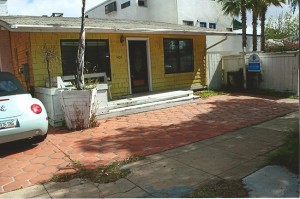
After:
Before:
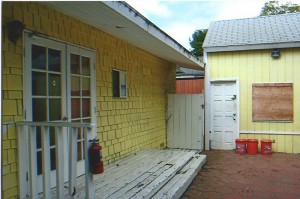
After:
